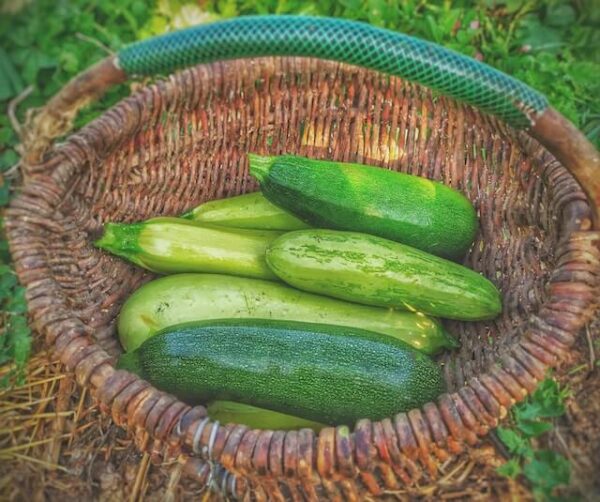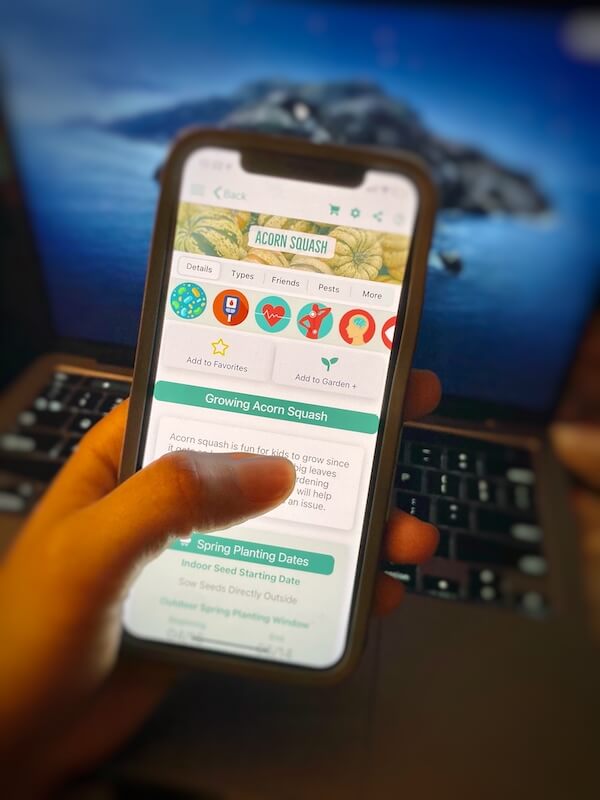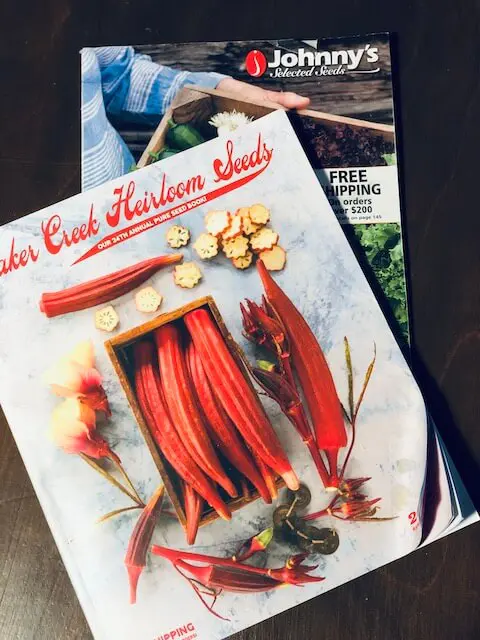How to Start Pepper Plants from Seeds
Do you want to grow your peppers? I will show you how to start pepper plants from seeds the easy way.
This post about how to start pepper plants from seeds may contain affiliate links, as an Amazon Associate I earn from qualifying purchases. Please read my Disclaimer for more information.
Growing peppers can be challenging for some gardeners, but they are a great addition to a vegetable garden.
We are sharing tips and tricks on how to start pepper plants from seeds.

All of this information will help you have a long growing season of your favorite pepper varieties.
Growing food is a very powerful skill to have and the key is to start growing food that you usually buy at the grocery store. Peppers are one of those vegetables that everybody usually grabs at their local supermarket.
Table of Contents
Imagine if you didn’t have to buy peppers…growing your own peppers would be wonderful!
Now, if you buy pepper plants to grow from your local big box store or plant nursery, there is nothing wrong with that but that will get pricey.
Learning how to grow peppers from seed will be beneficial and save you tons of money on pepper.
Where do I get pepper seeds?
You can get peppers in many different locations, including local big box stores, local gardens, and nurseries, and one of the best ways is online stores. Some of my favorite online stores are

Saving seeds from a pepper itself can also be used to grow new pepper plants.
Extract the pepper seeds from a pepper, place them in water to clean the seeds, air dry them on a surface, and then you can place them in soil.
There is a wide range of pepper seeds you can pick from the best way to do that is to pick seeds from a store that complements your growing climate.
Our best seeds stores to know the list is an amazing resource to help you find the best seed shop for your climate and needs.
Pepper growing supplies

2 Set 60-Cell Seed Starter Kit
This seed starting kit is a great starter kit as it gives you a tray and heating mat. You can always get the individual supplies we have listed below.

These seed starter trays are made of high-quality plastic, are durable, reusable, and come in these transparent domes to help give you a greenhouse effect that will aid germination.

A heating mat is an important thing to have because peppers seeds need heat under them to germinate.

If you are on a budget it’s not bad to get pepper seeds from Amazon but if you want seeds from a well-known source I recommend Botaical Interest Pepper Seeds.

Small pots & Larger containers
You can buy container to help move up your pepper seeds when they get bigger and use containers to grow your peppers.
Make sure to get container with good drainage or you can get grow bags that are porous and naturally have good drainage.
I recommend a 5 -10 gallon grow bag for peppers and one pepper plant per grow bag.

When choosing a fertilizer, it’s good to have a mix of liquid fertilizer and granular.
Dr. Earth Organic Vegetable & Herb (Granular)
Neptune’s Harvest Organic Hydrolized Fish & Seaweed Fertilizer(Liquid)

Indoor grow lights will extend your harvest and be a great addition to your indoor seed-starting setup. This is a great 6-pack LED grow light strip kit that I have myself and they get the job done.

If you want to use soil pods to start your seeds these pellets will do the job. All you have to do is add water and the pellet will expand.
Types of peppers
They are thousands of different types of peppers but a good rule of thumb is to figure out what peppers you use or eat regularly.
The amount of the chemical capsaicin in peppers is what sets each pepper apart. The more capsaicin a pepper has the hotter it will be.

A good way to find a pepper that will grow best in your area is to know your last frost date and identify where peppers are on the Scoville Heat Unit (SHU) scale.
On the Scoville Heat Unit scale hot peppers can be above 80,000 SHUs and mild peppers can be as low as 0-700 SHUs.
Since we can not name thousands of pepper types here we will give you the most popular peppers gardeners consider growing in their gardens.
Sweet peppers
- Shishitos
- Banana pepper
- Bell pepper
- Lamuyo-type sweet pepper
Mild pepper types
- Sweet Italian pepper
- Paprika peppers
- Poblano peppers
- Cherry peppers
Medium-hot pepper
- Serrano chile
- Scotch Bonnet
- Habaneros
- cayenne peppers
- Ghost chilies
- Tabasco pepper

Easiest peppers to grow
Bell peppers are one of the easiest peppers to grow as hot peppers can sometimes be a little bit more difficult.
Hardest peppers to grow
Usually, hot peppers are the hardest to grow because they need high temperatures to germinate.
Seeds starting methods
If you research ways to start pepper seeds, you’re going to find plenty of seed-starting methods that claim to be the best way to start your own seeds.
For the best results, the best way to start pepper seeds depends on what you think is the best for you. Seed starting can be a trial-and-error process because gardening in general is learning as you grow.
Below are some methods to consider and see what works best for you.
Damp paper towel method
This seed-starting method consists of placing seeds in a moist paper towel and then in a plastic bag to pre-sprout seeds before placing them in the soil.
Plastic seeds starting trays
The easiest way to start seeds is to buy plastic seed starting trays and potting soil. Place your seeds in the soil, keep them on a heating mat, keep the soil moist, and watch them grow.
Soil blocking
This is our preferred method because it uses less plastic and provides the seeds with a smaller surface area to help them germinate faster.
Learn more all about soil blocking by checking out our Soil Blocking: The Ultimate Guide for Beginners
Soil pods
Soil pods are widely used by many gardeners as you can get them in your local big box stores.
This is a very easy way to start a seed as you just add water to pods, watch them expand, then add seeds and watch your seed grow.
How to start pepper plants from Seeds
Soil preparation
They were different times when you have to prep the soil because you have to make sure you have the proper soil, depending on what phase you are in growing your pepper seeds.
Seed starting soil prep: When starting pepper seed you need soil that is nice and fluffy.
Buying any type of soil starting mix can work or you can make your own by adding soil, vermiculite, and perlite.

Transplanting soil prep: Adding, compost, perlite, and a general granular fertilizer to your soil before transplanting will make your soil healthy enough to grow peppers.
Sowing Pepper seeds
Pepper seeds are not that small and they are not that big either so you won’t have a problem sowing them.
Before you place any seed and soil, a good rule of thumb is to make sure your soil is already wet.
Planting each pepper seed at least a quarter deep in the soil is recommended.

To sow pepper seeds in the soil just pick it up with your fingertips and place it in any seed-starting method you have chosen.
A tip for sowing pepper seeds or any type of seed is to plant a seed down into the soil doubling its height.
After you plant your pepper seed, sprinkle some soil lightly on top or use vermiculite as well to hold moisture.

Germination process
Getting pepper seeds to germinate can be challenging for some gardeners because it can take a long time for them to germinate.
Pepper seed germination time can be between a week to 21 days depending on the pepper variety.

To get your pepper seeds to germinate use these tips:
- Keep your seeds in moist soil, never dry.
- Get a seed-starting mix that has organic matter aeration, such as vermiculite, or peat moss in it, and is well-drained soil.
- Keep the temperature under your seeds between 75 to 90°F. Hotter peppers will need up to 90° to germinate.
- Inspect your seeds to make sure they are a nice color and not molded or damaged.
- Make sure your seed starting station has a small fan or some time or air circulation to create healthy seedlings.
- Having patience is key because the process can take up to two-four weeks and for hotter peppers to germinate
- Having a mini greenhouse that gets direct sunlight and is located in a warm spot benefits seed-starting peppers.
You can also experiment with germinating pepper seeds instead of placing them in direct soil, some gardeners do pre-sprout them in various ways below:

- You can please pepper seeds in a wet paper towel into a Ziploc bag and wait for them to sprout.
- Another way is to put pepper seeds in the water for at least 24 to 48 hours before planting in the soil to soften the outer shell to let the plant break through easily.
- It’s also said you can place your pepper seeds in light chamomile tea to destroy any bacteria that can be caught on your seeds before sowing them in the soil.
Light requirements
When you’re starting pepper seeds you can put them on by a sunny windowsill or start seeds under grow lights.
When it comes to germinating pepper seeds, they do not need light to germinate but they need extra heat.

As long as you’re getting at least six hours of sunlight, they were able to grow with 8 to 12 hours of sunlight which is the maximum but as long as you have six hours of light, you can grow peppers.
Air requirements
When your pepper seeds finally grow into small pepper seedlings, it’s important to have air circulation around them.
Having a fan on low or simply brushing your hand over your ceilings, will help them make them stronger and be less leggy.
Providing a good amount of air circulation also prevents disease or mold that can affect your ceilings while they are growing.
Fertilizer
You don’t have to fertilize seeds in the beginning, just when they start to grow into seedlings.
After they have 3-4 inches of growth or have at least their first true set of leaves, give them a liquid fertilizer that is rich in nitrogen like fish emulsion once every two weeks to keep leaves green.
If you see the green leaves turn yellow it is a good indication to feed your pepper plants some fast nitrogen base liquid fertilizer.
After at least a month of growth providing your peppers with a granular fertilizer will slowly release through time and will help keep them healthy.

A balance of NPK is a good granular fertilizer to keep it simple, but to be more specific a 5-10-10 fertilizer with more potassium or phosphorus rather than nitrogen will be needed to get a good harvest of peppers.
When you finally transplant your peppers into their permanent location, fertilizing them once every two weeks will keep them healthy and keep them producing for you.
Hardening off pepper plants
A good time to harden off your pepper plants is when they’re about 4 weeks old. Harden off your plant as long as your pepper plants are at least 3 inches tall and have 3 sets of true leaves before they can come outside.

There are some things you should consider before hardening off your plants and after you harden them off for at least a week:
- Make sure they are large enough or are at least four weeks old before placing them outside
- Monitor the temperature outside, any temperature under 60 degrees Fahrenheit is too cold for peppers, and temperatures that are 95 degrees Fahrenheit, or higher are too hot.
- Make sure your plant does not dry out
- Be sure to protect your seedlings from wildlife especially if you have issues with small animals or insects in your area.
- If you’re just hardening them off, make sure you place them in a shady area instead of the full sun are so they will help them accumulate better.
Transplanting peppers
After your pepper seedlings are big enough to be put in their permanent location making sure you have soil that has various amounts of organic matter is important.

You will be transplanting your pepper plants that:
- Do not transplant when you have lower temperatures outside, cool nights, or when cold weather is coming.
- Pepper plants need a warm climate and the soil temperature outside should be between 65-70 degrees Fahrenheit.
- Have been growing for at least three to four weeks
- Plants should be at least 4-6 inches high
- Have at least 3-4 true leaves
- Need roots that touch the bottom, but are not circling the soil below causing them to be root bound.
- When you have all these checked, you can transplant your pepper plant into a bigger pot to continue to grow.
Topping off
Topping off a pepper plant is another word for pruning which means to snip off the center of the plant leaving at least 3-4 leaves or a node.

This helps pepper plants grow more flowers and eventually more peppers.
If you top off your pepper plant it will be bushier, stronger, and ultimately with provide a higher field of peppers.
A good time to top off your pepper plant is when it is about 6 inches tall or has been growing for at least 4 weeks.
Common problems
When you learn how to start pepper plants from seeds you might face some common problems below.
Leggy seedlings – Baby pepper plants can get leggy if they are too far from their light source.
Slow growth– If you’re noticing your plants are so slow growing, giving them some nitrogen liquid fertilizer (Fish Emulsion is a good choice) will give them a quick boost.

No germination-Always grow more than 2x more seeds than you expect. If you get no germination, don’t get discouraged, there are many reasons why you get no germination:
- The soil dried out: Keep your soil or potting mix moist and never dry so your seeds will have a higher chance to germinate. Never keep your soil drenched with water, but just lightly moist.
- Overwatering: If your soil is already moist, there’s no need to keep watering them until you see they are slowly trying to dry out then you water them again. Overwatering can drown your seeds to the point where they won’t be able to germinate as you were not providing enough oxygen to them.
- Not enough heat: Pepper seeds need heat for them to germinate so if you do not have a heating pad putting them on top of your refrigerator or a place that gets a lot of warmth in your home is beneficial. Sweet pepper seeds need about 70 to 85°F to germinate and hotter peppers need at least 80 to 90°F to germinate.
Yellow leaves– Sometimes when plants get bigger some leaves will turn yellow as they are trying to reach for more nutrients. Feeding them a nitrogen-based liquid fertilizer once every 1-2 weeks will green them right up.
Sunscald– When pepper plants start getting bigger they actually can’t tolerate too much heat. Temperatures in the 90s are too hot and may cause your leaves to burn up and you will sun burns on the leaves.
Pest & Disease

Depending on the moisture around your ceilings or seeds, that you sewed, you can get different types of passing diseases, like fly gnats, mold, or fungal infections on the soil.
To try to minimize passing disease make sure you are giving your seedlings a lot of air circulation by putting a little fan by them.
Try to decrease the amount of humidity if you are seeing any unusual color growth on your soil.
Placing or sprinkling some cinnamon on top of your seeds after sowing can also prevent disease or pests.
Keeping your baby pepper plants healthy will strengthen them and decrease the amount of passing disease throughout the whole growing season.

FAQ: How to start pepper plants from seeds
How many pepper seeds per hole?
Placing at least one to two seats per hole when you are seed-starting will increase your chances of germination.
How deep do you plant pepper seeds?
You should place your pepper seeds at least 1/4 of an inch down into the soil or a good rule of thumb to go by is placing any seed double in size down in the soil.

What is the fastest way to germinate pepper seeds?
The fastest way to germinate pepper seeds is to make sure that they have a heat source on the bottom of them that is between 75 to 90°F.
Another way you can quickly germinate your pepper seeds is by placing them in a wet paper towel or placing them in water for 24 hours to loosen the seed shell which can help your pepper plant grow quickly.
Can you plant seeds from a pepper?
Yes, you can plant seeds from a pepper by saving them from a pepper by drying them out before planting or saving them. Note that if you save seeds from a pepper at the grocery store you might have a low chance of germination because you don’t know how the pepper was grown.
Do pepper seeds need light to germinate?
Pepper plants do not need light to germinate but it won’t hurt them either way.

How long does it take for bell peppers to grow from seed?
Depending on many environmental factors in the area, growing your peppers pepper seeds can take up to 2 to 4 weeks to germinate and overall can take up to four months to completely make full-size peppers
Should I soak pepper seeds before planting?
You do not need to soak your pepper seeds before planting, but it’s always good to use multiple ways to start seeds to see what works best for you.
How to start pepper plants from seeds will get easier the more you get hands-on experience and will come up with your own tips and tricks.
I hope you learned how to start pepper plants from seeds, let me know if you used any of our tips in the comments below.
More food-growing posts!
How to grow carrots in Florida and Anywhere else!
How to Trim Basil Plants to Get An Unlimited Harvest!
Starting seeds indoors: Ultimate Beginner Guide
PIN FOR LATER

Don’t forget to spread the ❤️ Love & Share this Post!






